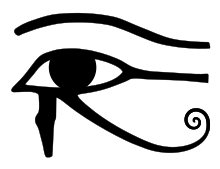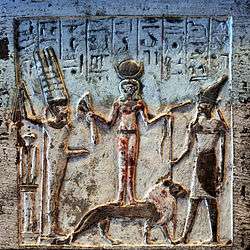Resheph
Resheph (also Reshef and many other variants; Phoenician: 𐤓𐤔𐤐, ršp; Eblaite Rašap, Egyptian ršpw) was a deity associated with plague (or a personification of plague), war, and sometimes thunder in ancient Canaanite religion. The originally Eblaite and Canaanite god was then more famously adopted into ancient Egyptian religion in the late Bronze Age during the Eighteenth Dynasty of Egypt (late fifteenth century BC), also becoming associated with horses and chariots.[1][2]

In Biblical Hebrew, רֶשֶׁף resheph is a noun interpreted as "flame, lightning" but also "burning fever, plague, pestilence".[3]
Etymology
Resheph is known by a multitude of names, including Rahshaf, Rasap, Rashap, Resep, Reshef, Reshpu, Rapha, Repheth, and others that are not standardized.[1][2]
Ebla
| ršpw in hieroglyphs |
|---|
The name is found in third millennium tablets from Ebla, as Rašap (Ra-ša-ap), listed as divinity of the cities of Atanni, Gunu, Tunip, and Shechem. Rasap was one of the chief deities of Ebla, with one of the four city gates named in his honor.[4]
References to ršp gn have been found at Ebla and Ugarit. These have been variously interpreted as associating Resheph with the shield and protection, or the city Gunu, or gardens, or the cemetery.[5][6][7]
Ugarit
Ršp was an important Ugaritic deity. He had the byname of tġr špš "door-warden of the Sun".[8] Sacrifices to Ršp (ršp gn) were performed in gardens.[9]
Ugaritic Ršp was equated with the Mesopotamian deity Nergal.[10] Fauth (1974) argued that ršp in the later Canaanite period no longer referred to a specific god and could be used as a byname, as in Rešep-Mikal at Kition.[8] Teixidor (1976) based on an epithet ḥṣ in Kition (interpreted as "arrow"), identifies Ršp as a plague god who strikes his victims with arrows as Homeric Apollo (Iliad I.42–55), and argues for an interpretatio graeca of Ršp with Apollo in Idalium.[11]
Resheph is mentioned in Ugaritic mythological texts such as the epic of Kirta[12] and The Mare and Horon.[13]
Although the iconography of Resheph shares the gazelle with that of the Egyptian-Canaanite Shed, Cornelius (1994) writes that "the rest of the attributes are totally different".[14]
Egypt
| Part of a series on |
| Ancient Egyptian religion |
|---|
 |
|
Beliefs |
|
Practices
|
|
Deities (list) |
|
Locations |
|
Symbols and objects
|
|
Related religions
|
|
|
Probably introduced in Egypt by the Hyksos, Resheph was not assimilated into the Egyptian pantheon until the New Kingdom's Eighteenth Dynasty along with other Near Eastern deities. His consort was Itum.[15][16] He was frequently associated with Seth and Montu, other deities related to war and plague, but he also formed a triad with Min and Qetesh. Qetesh was connected with Hathor, but not synonymous with her.
He was usually depicted anthropomorphically, as a man brandishing a weapon, sporting a typical Syrian beard, and wearing the white crown of Egypt and/or a gazelle’s head on his own.[15][16] A temple dedicated to him is attested in Memphis, but he was likely worshipped in many Nile Delta regions. His cult survived well into the Ptolemaic Period.[15]
As a war deity, he was related to kingship as shown by a stele erected by Amenhotep II near the Great Sphinx.[15] For the same reason, his bellicose nature became associated with fighting diseases such as abdominal pain, believed to be caused by a demon called Akha.[16]
The theonym is usually written as hieroglyphic ršpw, where the final -w is added in analogy to other Egyptian divine names.[17]
Hebrew Bible
In Biblical Hebrew, resheph רֶשֶׁף means "flame, firebolt", derived from שָׂרַף "to burn".[18] Resheph as a personal name, a grandson of Ephraim, occurs in 1 Chronicles 7:25 (here written as Rephah in King James Version). The Latin Vulgate renders his name as Rapha.[19]
In Habakkuk 3:5, describing the procession of Eloah (אֱל֙וֹהַ֙) from Teman and Mount Paran, mention deber and resheph as going before him, in the King James Version translated as "pestilence" and "burning coals". Due to the discovery of both deber and resheph as theonyms in Ebla, this passage has been reinterpreted as describing a procession of the retinue of El going to war with Yam.[20] In Job 5:7, there is mention of the "sons of resheph", translated in the Septuagint as νεοσσοὶ δὲ γυπὸς, "the young of the vulture",[21] and in the King James Version as "sparks".
In popular culture
In the 1998 animated historical film, Prince of Egypt, the Egyptian high priests Hotep and Huy invoke the name of Resheph (as Reshpu) during their song "Playing with the Big Boys now", as part of a pseudo-magical show to trick Moses.
In the book saga Lords of Deliverance from Larissa Ione, the fourth horseman is called Reseph, the personification of Sickness and Plagues and the brother of the first horseman Ares, personification of war, of the second horseman Limos (who is the only woman of the group), personification of Hunger, and of the third horseman Thanatos, personification of Death.
Notes
- "Reshep | Ancient Egypt Online".
- "Egyptian Gods: Resheph". egyptian-gods.org.
- רֶשֶׁף in Gesenius, Hebrew Lexicon.
- Giovanni Pettinato, The Archives of Ebla: An Empire Inscribed in Clay. Doubleday & Company, Inc., 1981 ISBN 0-385-13152-6
- Studi semitici, 1981
- López Grande, Maria José (October 1993). El dios Reshep: análisis arqueológico, iconográfico y epigráfico de una divinidad semítica. Madrid: Universidad Autónoma de Madrid. pp. 56–60, 68, 99–100, 136, 899, 901. hdl:10486/6913. ISBN 978-84-695-0421-5.
- del Olmo Lete, Gregorio; Sanmartín, Joaquín (12 February 2015). A Dictionary of the Ugaritic Language in the Alphabetic Tradition (2 vols): Third Revised Edition. BRILL. pp. 299–. ISBN 978-90-04-28865-2.
- Wolfgang Fauth: Rezension von: Wolfgang Helck: Betrachtungen zur Großen Göttin und den ihr verbundenen Gottheiten. In: Gnomon. 46.7 (1974), p. 689.
- Wiseman, D. J. (23 December 2013). "Mesopotamian Gardens". Anatolian Studies. 33: 143. doi:10.2307/3642702. JSTOR 3642702.
- Barré, M. L. (1 January 1978). "dLAMMA and Rešep at Ugarit: The Hittite Connection". Journal of the American Oriental Society. 98 (4): 465–467. doi:10.2307/599760. JSTOR 599760.
- Teixidor, Javier (1 January 1976). "The Phoenician Inscriptions of the Cesnola Collection". Metropolitan Museum Journal. 11: 65. doi:10.2307/1512684. JSTOR 1512684.
- tablet 1/CAT 1.14, column 1, lines 18-20; tablet 2/CAT 1.15, column 2, line 6
- CAT 1.100, lines 30-31
- Cornelius, Izak (1994). The Iconography of the Canaanite Gods Reshef and Baʻal: Late Bronze and Iron Age I Periods (C 1500-1000 BCE). Vandenhoeck & Ruprecht. p. 16. ISBN 978-3-7278-0983-5.
- Wilkinson, Richard H. (2003). The Complete Gods and Goddesses of Ancient Egypt. New York: Thames & Hudson. pp. 126–127. ISBN 978-0-500-05120-7.
- Hart, George (2005). The Routledge Dictionary of Egyptian Gods and Goddesses. London/New York: Routledge. p. 137. ISBN 0-203-02362-5.
- Reshef, Encyclopedia of Religion (2005).
- Strong's Concordance H7565
- "Latin Vulgate Bible with Douay-Rheims and King James Version Side-by-Side+Complete Sayings of Jesus Christ". latinvulgate.com.
- John Day, "New Light on the Mythological Background of the Allusion to Resheph in Habakkuk III 5", Vetus Testamentum 29.3 (1979), 353–355.
- Dunham, Kyle (2016). The Pious Sage in Job: Eliphaz in the Context of Wisdom Theodicy. Wipf and Stock Publishers. p. 24, footnote 30. ISBN 978-1-4982-7459-3.
- Wolfgang Helck: Die Beziehungen Ägyptens zu Vorderasien im 3. und 2. Jahrtausend v. Chr., (Ägyptologische Abhandlungen, Band 5) 2. Auflage, Harrassowitz, Wiesbaden 1971 ISBN 3-447-01298-6 (Zu Reschef in Ägypten: S. 450-454)
- Lipiński, Edward. Resheph: A Syro-Canaanite Deity. Peeters, 2009. ISBN 978-90-429-2107-8.
- Münnich, Maciej M. The God Resheph in the Ancient Near East. Mohr Siebeck, 2013. ISBN 978-3-16-152491-2.
- Tazawa, Keiko. Syro-Palestinian Deities in New Kingdom Egypt: The Hermeneutics of Their Existence. British Archaeological Reports, 2009. ISBN 978-1-4073-0448-9.

